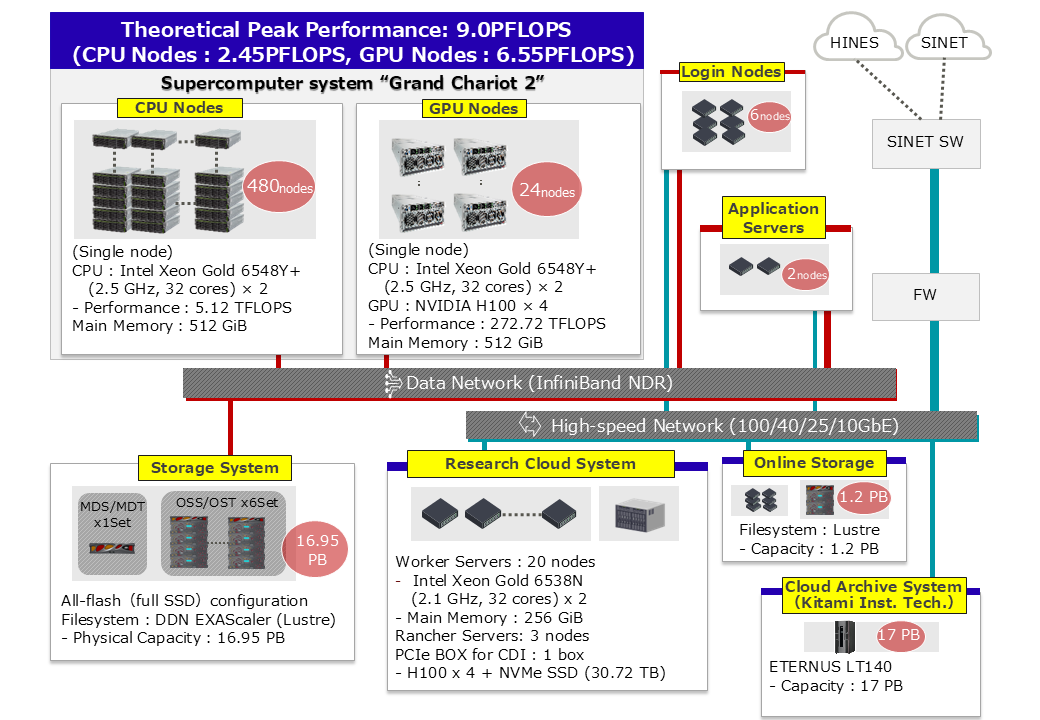Interdisciplinary Large-scale Computing System
Interdisciplinary large-scale computing system (full system) overview
[Overview]
In April 2025, the Information Initiative Center at Hokkaido University updated its “Interdisciplinary Large-Scale Computing System,” which primarily consists of supercomputing and cloud-computing systems, with an upgraded next-generation system based on Fujitsu PRIMERGY servers. Official operations are scheduled to begin in July 2025.
This system is used for research and development related to computational science, computer science, data science, and AI science in Hokkaido University and other universities and institutes in Japan, and provides resources for open collaborative research of innovative High Performance Computing Infrastructure (HPCI)*1 and Joint Usage/Research Center for Interdisciplinary Large-scale Information Infrastructures (JHPCN).*2 In addition to academic researchers such as universities, this system supports researchers nationwide including companies and other private institutions. Furthermore, this system can be utilized for education related to computational science, computer science, data science, AI science, and human resource development, with expected contribution to the development of various fields. With the introduction of this system, the Hokkaido University Information Initiative Center will provide further contribution to society.
[System details]
The supercomputer system has a computing subsystem named “Grand Chariot 2,” which provides 9 Petaflops*3 of theoretical peak performance, 2.27 times that of the previous system, and a 16.95 Petabytes*4 storage system. All components are interconnected via a high-speed InfiniBand*5 network. The computing subsystem consists of 504 compute nodes with 5th-generation Intel Xeon CPUs, and 24 of those nodes are each equipped with four NVIDIA H100 GPUs*6. The storage system is fully comprised of SSD flash memory (i.e., an all-flash storage system). The supercomputer system offers the same two usage courses as the previous system: exclusive and shared courses. A portion of computing resources for the shared course is available through collaborative research projects by HPCI, JHPCN, and Exploratory Joint Research Projects carried out by the Information Initiative Center. With its enhanced performance, the new supercomputer system supports a growing number of researchers, including existing users, while also addressing increasing demands in the AI and machine learning fields through its newly integrated GPU nodes.
The research cloud-computing system adopts Fujitsu’s PRIMERGY CDI (Composable Disaggregated Infrastructure), which uses a PCIe fabric to flexibly connect and manage PRIMERGY servers equipped with 5th-generation Intel Xeon CPUs, NVIDIA H100 GPUs, and NVMe SSDs. On the software side, the system migrates from traditional virtualization environments to Kubernetes-based container environments, using SUSE’s Rancher Prime. Building on these foundational technologies, the new cloud system offers interactive computing through a Jupyter environment, along with application deployment via shared or dedicated Kubernetes clusters.
In addition, a tape-based remote archiving system at the Kitami Institute of Technology makes periodic backups of critical data. This helps protect crucial research data in the event of a disaster.
[Glossary]
*1 HPCI (High Performance Computing Infrastructure): HPCI is a shared computational environment that connects major supercomputers including the flagship supercomputer “Fugaku” as well as storages of universities and research institutions in Japan via high-speed networks (SINET6) (https://www.hpci-office.jp/en).
*2 JHPCN (Joint Usage/Research Center for Interdisciplinary Large-scale Information Infrastructures): A center formed by eight universities (Hokkaido University, Tohoku University, the University of Tokyo, Institute of Science Tokyo, Nagoya University, Kyoto University, Osaka University, Kyushu University) equipped with supercomputers. It is a network for shared use/joint research, with the Information Technology Center of the University of Tokyo serving as the core of the system. It is accredited by the Minister of Education, Culture, Sports, Science and Technology as a site for providing university research facilities for use by researchers nationwide (https://jhpcn-kyoten.itc.u-tokyo.ac.jp/en/).
*3 Petaflops: A unit that measures the processing performance of a computer and represents the ability to calculate 10 to the order of 15 (1,000,000,000,000,000) floating-point operations per second.
*4 Petabytes: A unit of data storage which represents 10 to the order of 15 (1,000,000,000,000,000) byte.
*5 InfiniBand: A high-speed network technology which connects compute nodes to each others.
*6 GPU: Abbreviation for Graphics Processing Unit. GPU was developed as a dedicated computing device for graphic processing. It is currently used for large scale computational processing as well as computational processing related to artificial intelligence.



